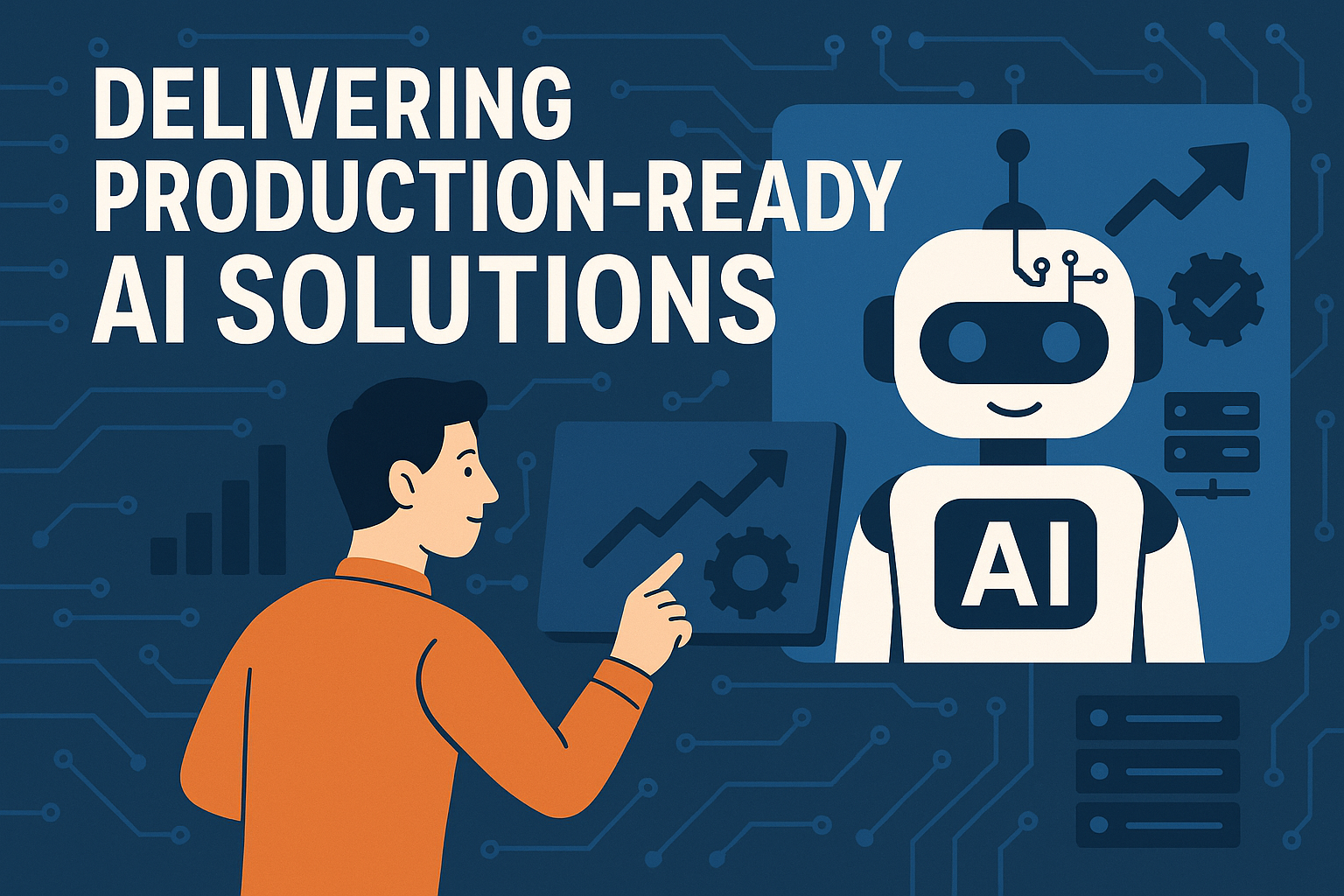Beyond the Demo
The promise of AI-powered solutions is compelling across industries: intelligent automation, predictive analytics, personalized customer experiences, and decision support systems that transform how businesses operate. However, there’s a significant gap between a working proof-of-concept and a system that can reliably serve your business day in and day out.
Many organizations discover this gap the hard way: after investing in what appears to be a complete solution, only to find it struggles under real-world conditions. The difference lies not in the core AI technology, but in the production architecture that surrounds it.
The Hidden Complexity of “Simple” AI Systems
AI solutions often appear deceptively straightforward in demonstrations. Whether it’s a chatbot handling customer inquiries, a recommendation engine personalizing user experiences, or a computer vision system processing images, the core functionality seems clear and manageable. This fundamental approach works well for controlled demonstrations and pilot projects, but production environments introduce challenges that aren’t immediately obvious.
Consider what happens when your AI system gains adoption across your organization or customer base. Suddenly, hundreds of requests are processed simultaneously, each triggering resource-intensive operations. Without proper infrastructure, response times slow to a crawl, or worse, the system becomes unresponsive entirely. What started as an exciting technological advancement becomes a source of frustration and lost business opportunities.
Security: More Than Just Private Hosting
Many organizations assume that hosting AI models on their own servers solves security concerns. While keeping data within your infrastructure is important, it’s only the beginning of a comprehensive security strategy.
Production-ready systems require granular access controls that align with your business requirements. Different user groups need different levels of access to data and functionality. Sensitive information must be protected not just from external threats, but also from unauthorized internal access. This means implementing robust authentication, authorization, and audit trails that track who accessed what data and when.
Data encryption becomes crucial, not just for data at rest and in transit, but also for the intermediate processing steps that occur during AI inference. Whether you’re processing customer data, financial information, or proprietary business intelligence, comprehensive security architecture ensures that even privately hosted systems maintain the highest security standards.
Performance Under Pressure
AI models are resource-intensive by nature, and enterprise AI systems often handle multiple complex operations simultaneously: data processing, model inference, real-time analytics, and response generation. Without careful architectural planning, these operations can create bottlenecks that bring systems to a halt.
Production systems require intelligent resource management. This includes request queuing to prevent system overload, load balancing to distribute work efficiently, and caching strategies to avoid redundant processing. The goal is ensuring consistent performance whether you have one user or thousands of users interacting with your AI system simultaneously.
Smart resource allocation also means having strategies for handling different types of requests. A simple query shouldn’t consume the same computational resources as a complex analytical task. Production architectures include mechanisms to prioritize and route requests appropriately based on complexity and business criticality.
Reliability and Monitoring
In production environments, system failures aren’t just inconveniences. They’re business disruptions. When customers, employees, or business processes depend on AI systems for critical operations, downtime directly impacts revenue, productivity, and customer satisfaction.
Comprehensive monitoring goes beyond tracking AI model accuracy and performance. Production systems require infrastructure monitoring that tracks server health, database performance, network connectivity, and resource utilization. This creates early warning systems that can identify and address issues before they impact users.
Effective monitoring also includes business-level metrics: system response times, user satisfaction rates, error patterns, and usage trends. This intelligence drives continuous optimization and helps justify ongoing investment in AI capabilities.
Scalability Architecture
Organizations change, and successful AI systems must adapt accordingly. A solution that works perfectly for a 50-person company may struggle when that company grows to 500 employees, or when they need to process ten times as many documents.
Production architectures are designed with scalability in mind from the beginning. This means using component-based designs where individual pieces can be scaled independently. Data processing capabilities can grow separately from inference handling, and storage can expand without disrupting user experience.
Geographic distribution becomes important for organizations serving multiple regions or global customer bases. A system that performs well in your primary data center might be too slow for users in different time zones or geographic locations. Production architectures consider network topology and implement strategies like content distribution and regional processing capabilities.
Data Management and Governance
In development environments, data often comes from controlled test sets. Production systems must handle the messy reality of enterprise data: information in multiple formats, varying quality levels, inconsistent standards, and constant updates from diverse sources.
Robust data pipelines become essential for processing and updating AI systems without disrupting service. This includes automated quality checks, version control for datasets, and mechanisms for handling data that doesn’t fit standard patterns. For AI systems processing real-time data streams, this complexity multiplies significantly.
Compliance requirements add another layer of complexity. Many organizations must adhere to industry regulations regarding data retention, privacy, and access controls. Production architectures incorporate these requirements from the ground up rather than trying to retrofit compliance later.
Integration with Existing Systems
AI systems don’t operate in isolation. They must integrate seamlessly with existing technology infrastructure and business workflows. This might include customer relationship management systems, enterprise resource planning platforms, data warehouses, authentication systems, and various third-party services.
Production architectures plan for these integrations early, creating standardized interfaces and data exchange mechanisms. This prevents the AI system from becoming an isolated tool that requires separate maintenance and creates additional complexity for users and administrators.
The Cost of Cutting Corners
The temptation to skip production-ready architecture is understandable. Additional infrastructure components increase complexity and initial costs. However, the long-term costs of inadequate architecture far exceed the upfront investment.
Organizations that deploy AI systems without proper production foundations often face escalating maintenance costs, security incidents, performance problems, and user dissatisfaction. Eventually, they must rebuild their systems with proper architecture, at much higher cost than doing it correctly from the beginning.
Moving Forward Thoughtfully
Building production-ready AI systems requires more than technical expertise. It demands understanding of business operations, regulatory requirements, and organizational dynamics. The most successful AI deployments result from partnerships between technology providers who understand these complexities and organizations ready to invest in robust solutions.
The AI transformation across industries is real, but realizing its benefits requires moving beyond impressive demonstrations to systems that can reliably serve your business for years to come. The difference between a promising pilot and a transformative business tool lies in the architecture that supports it.
When evaluating AI solutions, look beyond the core functionality to understand the production readiness of the complete system. Ask about security controls, performance under load, monitoring capabilities, and scalability plans. The answers will reveal whether you’re looking at a demo-ready system or a production-ready business solution.
The organizations that will gain the most from AI technology are those that approach it with the same rigor they apply to other critical business systems, because that’s exactly what these systems become when implemented correctly.
Read more about our AI delivery methods:





